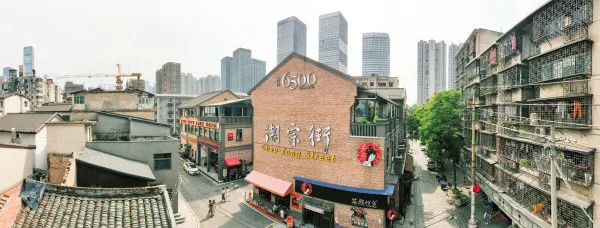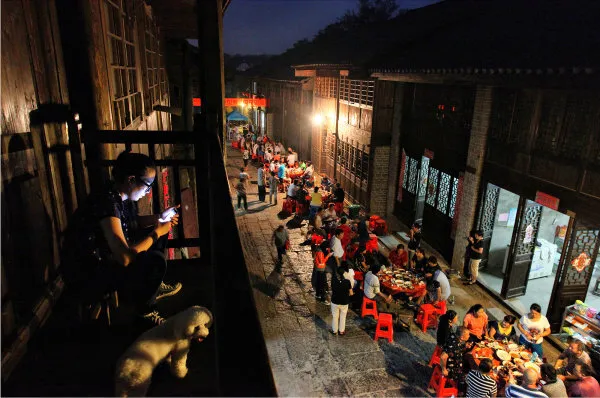Hunan builds characteristic protection and inheritance system for urban and rural history and culture
2024-04-03

History is the memory of a city, and culture is the soul of a city. In the process of urban and rural construction, Hunan adheres to the concept of rational utilization as well as inheritance and development, and builds a distinctive urban and rural historical and cultural protection and inheritance system.
As of the end of December 2023, there were a total of 269 historical and cultural cities, towns and villages, 53 historical and cultural blocks and 2,590 historical buildings in Hunan Province.
The ancient cities, towns, villages, streets, courtyards and houses connect the history and future of Hunan.
Chaozong Street is located in the center of Changsha City, with a history of over 400 years. It’s one of the only four ancient granite-paved streets in Changsha.
In the past, the Chaozong Gate was a necessary gateway to enter Changsha.

The old street had incomplete infrastructure and inconvenient living conditions for residents many years ago. In 2018, Kaifu District of Changsha City launched the organic renewal work of the old urban areas to improve the quality of blocks.
As a memory of the Ming and Qing dynasties, Chaozong Street has been listed as a provincial historical and cultural block. It preserves the streets and alleys formed since the Ming and Qing dynasties, historical relics such as the Song ancient city wall ruins, as well as multiple cultural relics protection units and protected modern buildings such as Chaozong Street Church and Jiuruli Mansion.
While preserving the characteristics of the era and original styles as possible, Chaozong Street has completed the renovation of water pipelines, electricity supply systems, roads and public toilets, etc., and improved the supporting facilities for fire protection and public spaces. Ancient buildings have been repaired. High-quality business formats have been introduced to revitalize the street.
Liuzi Street Historical and Cultural Block is the only national historical and cultural block in the province.
As a memory of the Ming and Qing dynasties, Chaozong Street has been listed as a provincial historical and cultural block. It preserves the streets and alleys formed since the Ming and Qing dynasties, historical relics such as the Song ancient city wall ruins, as well as multiple cultural relics protection units and protected modern buildings such as Chaozong Street Church and Jiuruli Mansion.
While preserving the characteristics of the era and original styles as possible, Chaozong Street has completed the renovation of water pipelines, electricity supply systems, roads and public toilets, etc., and improved the supporting facilities for fire protection and public spaces. Ancient buildings have been repaired. High-quality business formats have been introduced to revitalize the street.
Liuzi Street Historical and Cultural Block is the only national historical and cultural block in the province.

The Liuzi Family Banquet originated in the mid-Tang Dynasty, when neighboring villagers held a banquet to thank Liu Zongyuan (a famous politician, ideologist and litterateur in the Tang Dynasty) for caring about the people’s sufferings.
Later on, it developed into a traditional custom of the local Double Ninth Festival.
The Liuzi Family Banquet is well-known, but due to weather conditions, outdoor banquets often cannot be held on time and cannot meet personalized needs of family banquets and business receptions.
In September 2023, the Liuzi Family Banquet Hall built by a culture and tourism company in Yongzhou City was open to the public, fully exploring the history and value inheritance behind local culinary culture and solving the problems in the development of the ancient street.
In 2022, the province issued an implementation plan on strengthening protection and inheritance of history and culture in urban and rural construction. It pointed out that the utilization of historical and cultural blocks and historic areas should be promoted, specific functional areas of cultural display, traditional residences, and characteristic commerce should be built, and the integration of historical and cultural resources with modern tourism landscapes should be achieved.
Liuzi Family Banquet is an example of utilization of history and culture in innovative ways. As night falls, the service staff dressed in ancient clothes serve the dishes. The ancient shops are hung with red lanterns on both sides of the street, and wine flags and trademark signs fly with the wind. People from different places enjoy the local family banquet together.
During the last year’s Mid-Autumn Festival and National Day holiday, Liuzi Family Banquet Hall hosted more than 500 people a day at most.


